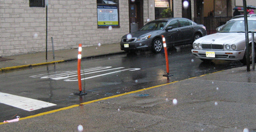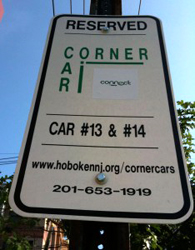A Park Slope resident who was suddenly transported to Hoboken through some sort of Star Trek-style transporter could be forgiven for thinking he was still at home. Washington Street, the main commercial strip in this New Jersey city, bears an uncanny resemblance to Seventh and Fifth Avenues, and many of the city’s old apartments and 19th-century buildings are virtually indistinguishable from those in brownstone Brooklyn.
 Hoboken boasts some of the best transit options in the country, with buses, the PATH train, commuter rail, and ferries among the options available. Yet the city also faces a problem familiar to any Park Sloper: too many cars and too few places to park them. In fact, it speaks volumes about parking in city life that the agency charged with finding solutions to the city’s traffic woes is called the Department of Transportation and Parking.
Hoboken boasts some of the best transit options in the country, with buses, the PATH train, commuter rail, and ferries among the options available. Yet the city also faces a problem familiar to any Park Sloper: too many cars and too few places to park them. In fact, it speaks volumes about parking in city life that the agency charged with finding solutions to the city’s traffic woes is called the Department of Transportation and Parking.
On Sat., Oct. 29, members of the Park Slope Civic Council met with the department’s director, Ian Sacs, to explore the innovative ways Hoboken is approaching these problems, with the hope of importing some of the solutions to Brooklyn.
Corner Cars
As in Park Slope, many cars on Hoboken’s streets are moved only for street cleaning, grocery runs, and the occasional weekend trip, limiting overall parking availability. In an effort to allow people the convenience of car ownership without the associated hassles, Hoboken offers residents membership in a citywide car-sharing program.
Administered by Hertz Connect through a contract with the city, Corner Cars are placed in dedicated spaces at corners throughout the city. Car sizes range from SUVs to compacts. People enjoy the convenience of a car-sharing program — hourly rates, free gas, etc. — with the added benefit of guaranteed parking at the end of their trip, eliminating endless circling and the associated wasted fuel.
For the city, the overall effect has been reduced demand for parking. Surveys say that for each Corner Car, more than 17 households give up their cars entirely. Others postpone or avoid car ownership altogether. Sacs estimated that the program is responsible for over 750 fewer vehicles on Hoboken streets.
Residential Parking Permits
One of Sacs’ most effective but controversial initiatives has been the strict enforcement of residential parking permits. Permits had been a part of Hoboken’s traffic mix before, but the application process and enforcement were so lax that Hoboken was seen as a Park-N-Ride lot. Commuters would drive in from outer areas, park for free, then continue on to jobs in Manhattan via the PATH or ferry.
Today, applicants must provide a valid New Jersey driver’s license with a legal Hoboken address, as well as a current New Jersey registration with a matching address. Parking permits cost just $15 annually. (Business, temporary, and visitor permits are also available.) The city still has metered parking along main commercial streets, allowing out-of-towners to shop and dine in Hoboken as before.
With rigorous permit enforcement, Hoboken has been able to reduce the number of cars searching for parking, at least by a little. As stated on Hoboken’s website, “There is simply not enough curb space to provide parking for everyone who chooses to own a car in Hoboken.”
Pedestrian and Bicyclist Safety
Hoboken is a walking city, yet decades of accommodating automobiles rendered some areas dangerous for pedestrians. With a goal of enabling a friendlier, safer streetscape, Sacs implemented a broad range of initiatives centered on the three E’s: education, enforcement, and engineering.

While the official speed limit in Hoboken is 25 miles per hour, Sacs began a “Twenty is Plenty” education campaign to slow down drivers. Studies have shown that a pedestrian hit by a driver at 30 mph has a 45% chance of dying, but at 20 mph, the risk drops to just 5%. The campaign is promoted with signage and even on the residential parking permits themselves.
To further increase pedestrian safety, Sacs’ office embarked on an ambitious “daylighting” program, eliminating parking spaces at strategic intersections to increase visibility. Drivers can now more easily see pedestrians; pedestrians are more able to see approaching cars. Eliminating parking didn’t earn Sacs too many friends at first, but the safety benefits have outweighed the criticism: Since 2009 there has been a 30% reduction in pedestrian injuries from motor vehicles.
Moreover, nearly 80% of city streets have bike lanes, resulting in 63% fewer collisions in the last two years. Hoboken police are also aiding the effort, enforcing double-parking regulations, blocked crosswalks, and other traffic violations with greater frequency.
Sacs’ ideas have not always been popular, but they have been effective. The key, he noted, is communication. He often fields calls from residents directly, and tries to convince them that the city’s programs benefit everyone, car owners included.
“The idea is not to tell people they cannot own a car,” Sacs said. Rather, cities should provide a multitude of options for residents so that they can choose to not own one in the first place. If they do, they’ll make life easier for the many people currently searching for a parking space.
— Doug Gordon, a resident of Fourth Avenue, blogs about bicycling, livable streets, and sustainable transportation at BrooklynSpoke.com.
from the November 2011 Civic News

